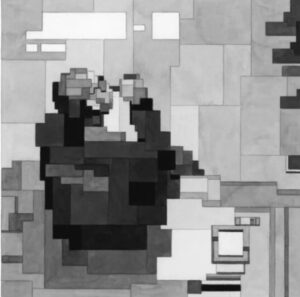Harvey Pearson, the film’s director, describes What You Do Alone as an extension of his creative connection with SALPA (Luke), the artist behind the album. Pearson was deeply moved by the themes of SALPA’s work—introspection, transformation, and emotional contrast—and set out to create a visual journey that mirrors the emotional depth of the music. Set against the evocative landscapes of Catalunya, the film navigates the dualities of existence—light and darkness, fire and water, loss and hope—all serving as metaphors for personal growth.
Thematic Exploration of What You Do Alone
The Duality of Light and Darkness
Pearson emphasizes that What You Do Alone explores contrast, particularly the balance between light and darkness. This duality is a fundamental aspect of storytelling, representing the emotional and psychological struggles within a character’s journey.
Films frequently use light and darkness as metaphors for clarity and confusion, hope and despair, knowledge and ignorance. In What You Do Alone, these contrasts could manifest visually—perhaps through shifting cinematographic techniques, where scenes of emotional turmoil are cast in shadow, while moments of revelation are bathed in light.
Musically, the soundtrack can enhance this thematic contrast. The song “What You Do Alone” may begin with sparse, melancholic instrumentation to reflect isolation, gradually building toward a more expansive and textured arrangement as the character moves toward self-discovery. This evolving musical arc mirrors the protagonist’s internal shift, reinforcing the idea that struggle and resolution are deeply interconnected.
Solitude and Self-Discovery
The film’s title itself, What You Do Alone, suggests that solitude is a central theme. Pearson’s statement implies that the film is not just about loneliness, but about what one does with solitude—how it shapes identity, growth, and resilience.
Many films explore solitude as a vehicle for self-discovery. In Lost in Translation (2003), for example, isolation in an unfamiliar place forces the characters to re-evaluate their lives. Similarly, Into the Wild (2007) portrays solitude as both liberating and challenging, ultimately leading to an emotional epiphany.
In What You Do Alone, solitude might be depicted as both a struggle and an opportunity for growth. The landscapes of Catalunya may play an integral role in emphasizing this theme, as vast, open spaces often symbolize introspection, while enclosed or urban settings might represent emotional entrapment.
The soundtrack, in turn, can underscore this duality. A lone, echoing guitar or piano line could highlight the weight of isolation, while layered harmonies and swelling compositions might indicate moments of realization and acceptance.
Transformation Through Contrast
Pearson’s mention of “fire and water, loss and hope” suggests that the film’s core message is one of transformation. Fire and water are often opposing yet complementary forces—fire represents passion, destruction, and renewal, while water signifies fluidity, change, and emotional depth. Their presence in the film could symbolize the way personal transformation often requires both destruction (letting go of old beliefs, confronting past wounds) and renewal (embracing change, finding peace).
A great example of transformation through contrast is seen in The Fountain (2006), where visual and musical elements work together to explore cycles of loss and rebirth. In What You Do Alone, we might see these themes play out through changing environments, shifting tones in cinematography, and the gradual evolution of the protagonist’s emotional state.
SALPA’s music likely plays a crucial role in conveying this transformation. If the soundtrack starts with subtle, melancholic tones and progressively incorporates richer layers of sound, it could reflect the character’s emotional progression from struggle to acceptance.
The Role of Catalunya’s Landscapes
Pearson describes the landscapes of Catalunya as a key storytelling element in What You Do Alone. Natural settings often act as external manifestations of a character’s inner world, reinforcing emotional themes through visual symbolism.
Open landscapes (hills, coastlines) – Could symbolize emotional clarity, a sense of freedom, or self-realization.
Forests or mountains – Might represent emotional barriers, challenges, or the unknown.
Water (rivers, oceans, rain) – Often symbolizes change, rebirth, or deep emotions.
A common cinematic technique is using landscape changes to reflect a character’s emotional journey. For instance, in Wild (2014), Reese Witherspoon’s character moves from rugged, difficult terrain to open, expansive vistas as she overcomes personal struggles. What You Do Alone might use a similar approach, shifting between different natural elements to signify changes in the protagonist’s mindset.
Music can further emphasize these visual shifts. A tranquil, minimalist score could accompany scenes of solitude in an open field, while dynamic, layered sounds might build as the character reaches an emotional climax.
The Soundtrack’s Emotional and Narrative Role
“What You Do Alone” as a Leitmotif
In many films, a central song serves as a leitmotif—a recurring musical theme that reinforces key emotional moments. What You Do Alone, as the film’s title track, likely functions in this way.
• Opening Scene: The song may be introduced in a minimal form, setting the tone for solitude and introspection.
• Emotional Climax: A richer, more intense arrangement might play during a moment of realization or breakthrough.
• Final Scene: The song could return in a fully realized form, symbolizing acceptance and closure.
This technique is used effectively in films like Her (2013), where Arcade Fire’s melancholic yet hopeful score evolves alongside the protagonist’s emotional journey. Similarly, in What You Do Alone, the title track could act as an anchor, subtly shifting to reflect the character’s growth.
The Soundtrack as a Reflection of Inner Turmoil
Music in What You Do Alone likely mirrors the protagonist’s evolving emotions, creating an immersive experience where sound and narrative are deeply intertwined.
• Sparse, ambient sounds – Could reflect loneliness or internal conflict.
• Layered vocals and rich harmonies – Might indicate emotional connection or self-acceptance.
• Crescendo moments – Could accompany revelations or turning points.
This dynamic use of music can be seen in Euphoria (TV series), where Labrinth’s score shifts between haunting minimalism and grand, sweeping compositions to reflect character emotions. In What You Do Alone, a similar approach could be used to heighten emotional impact.
A Cinematic and Musical Meditation on Growth
At its core, What You Do Alone is a story about the transformative power of solitude. Through Pearson’s direction and SALPA’s music, the film explores deep emotional contrasts—light and darkness, loss and hope, fire and water—each serving as a metaphor for personal growth.
The landscapes of Catalunya are more than just a setting; they actively shape the film’s emotional weight, reinforcing themes of introspection, isolation, and self-acceptance. Meanwhile, the soundtrack serves as both an emotional guide and a narrative force, mirroring the protagonist’s journey through its evolving sonic textures.
No comments yet.







